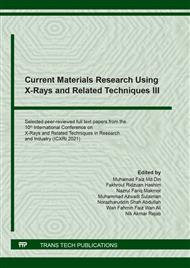[1]
FAO, The State of World Fisheries and Aquaculture (SOFIA), FAO, Rome, Italy, (2020).
Google Scholar
[2]
M. Boutinguiza, J. Pou, R. Comesaña, F. Lusquiños, A. De Carlos, B. León, Biological hydroxyapatite obtained from fish bones, Mater. Sci. Eng. C 32 (2012) 478–486.
DOI: 10.1016/j.msec.2011.11.021
Google Scholar
[3]
K. Prabakaran, S. Rajeswari, Development of Hydroxyapatite from Natural Fish Bone Through Heat Treatment, 20 (2006) 20–23.
Google Scholar
[4]
A.N.K.A. Fara, M.A. Yahya, H.Z. Abdullah, Preparation and Characterization of Biological Hydroxyapatite (HAp) Obtained from Tilapia Fish Bone, Adv. Mater. Res. 1087 (2015) 152–156.
DOI: 10.4028/www.scientific.net/amr.1087.152
Google Scholar
[5]
N.A.S.M. Pu'ad, P. Koshy, H.Z. Abdullah, M.I. Idris, T.C. Lee, Heliyon Syntheses of hydroxyapatite from natural sources, Heliyon, 5 (2019) e01588.
DOI: 10.1016/j.heliyon.2019.e01588
Google Scholar
[6]
N.A.M. Barakat, K.A. Khalil, F.A. Sheikh, A.M. Omran, B. Gaihre, S.M. Khil, H.Y. Kim, Physiochemical characterizations of hydroxyapatite extracted from bovine bones by three different methods: Extraction of biologically desirable HAp, Mater. Sci. Eng. C 28 (2008) 1381–1387.
DOI: 10.1016/j.msec.2008.03.003
Google Scholar
[7]
A.S. Hammood, S.S. Hassan, M.T. Alkhafagy, H.L. Jaber, Effect of calcination temperature on characterization of natural hydroxyapatite prepared from carp fish bones, SN Appl. Sci. 1 (2019).
DOI: 10.1007/s42452-019-0396-5
Google Scholar
[8]
T.M. Coelho, E.S. Nogueira, W.R. Weinand, W.M. Lima, A. Steimacher, A.N. Medina, M.L. Baesso, A.C. Bento, Thermal properties of natural nanostructured hydroxyapatite extracted from fish bone waste Thermal properties of natural nanostructured hydroxyapatite extracted from fish bone waste, 084701 (2013).
DOI: 10.1063/1.2718866
Google Scholar
[9]
B. Mondal, S. Mondal, A. Mondal, N. Mandal, Fish scale derived hydroxyapatite scaffold for bone tissue engineering, Mater. Charact. 121 (2016) 112–124.
DOI: 10.1016/j.matchar.2016.09.034
Google Scholar
[10]
W. Pon-On, P. Suntornsaratoon, N. Charoenphandhu, J. Thongbunchoo, N. Krishnamra, I.M. Tang, Hydroxyapatite from fish scale for potential use as bone scaffold or regenerative material, Mater. Sci. Eng. C 62 (2016) 183–189.
DOI: 10.1016/j.msec.2016.01.051
Google Scholar
[11]
J. Venkatesan, P.D. Rekha, S. Anil, I. Bhatnagar, P.N. Sudha, C. Dechsakulwatana, K. Se-Kwon, M.S. Shim, Hydroxyapatite from Cuttlefish Bone: Isolation, Characterizations, and Applications, Biotechnol. Bioprocess Eng. 23 (2018) 383–393.
DOI: 10.1007/s12257-018-0169-9
Google Scholar
[12]
I. Zainol, N.M. Alwi, M.Z. Abidin, H.M.Z. Haniza, M.S. Ahmad, A. Ramli, Physicochemical properties of hydroxyapatite extracted from fish scales, Adv. Mater. Res. 545 (2012) 235–239.
DOI: 10.4028/www.scientific.net/amr.545.235
Google Scholar
[13]
N. Bano, S. S. Jikan, H. Basri, S. Adzila, A. H. Nuhu, Natural Hydroxyapatite Extracted From Bovine Bone, J. Sci. Technol. 9 (2017) 22–28.
DOI: 10.1063/1.5089399
Google Scholar
[14]
S. Heo, S. Ko, G. Oh, N. Kim, I. Choi, W. S. Park, W. Jung, Fabrication and characterization of the 3D-printed polycaprolactone/fish bone extract scaffolds for bone tissue regeneration, J. Biomed. Mater. Res. - Part B Appl. Biomater. 107 (2019) 1937–(1944).
DOI: 10.1002/jbm.b.34286
Google Scholar
[15]
G. H. Yue, H. R. Lin , J. L. Li, Tilapia is the Fish for Next-Generation Aquaculture, Int J Marine Sci Ocean Technol. 3(1) (2016) 10–13.
Google Scholar
[16]
C.M. Lopatin, V. Pizziconi, T.L. Alford, T. Laursen, Hydroxyapatite powders and thin films prepared by a sol-gel technique, Thin Solid Films 326 (1998) 227–232.
DOI: 10.1016/s0040-6090(98)00531-8
Google Scholar
[17]
H. Madupalli, B. Pavan, M.M.J. Tecklenburg, Carbonate substitution in the mineral component of bone: Discriminating the structural changes, simultaneously imposed by carbonate in A and B sites of apatite, J. Solid State Chem. 255 (2017) 27–35.
DOI: 10.1016/j.jssc.2017.07.025
Google Scholar
[18]
M. Figueiredo, A. Fernando, G. Martins, J. Freitas, F. Judas, H. Figueiredo, Effect of the calcination temperature on the composition and microstructure of hydroxyapatite derived from human and animal bone, Ceram. Int. 36 (2010) 2383–2393.
DOI: 10.1016/j.ceramint.2010.07.016
Google Scholar
[19]
A.N.K.A. Fara, H.Z. Abdullah, Characterization of derived natural hydroxyapatite (HAp) obtained from different types of tilapia fish bones and scales, AIP Conf. Proc., 1669 (2015) 020077.
DOI: 10.1063/1.4919215
Google Scholar
[20]
H. Begam, B. Kundu, A. Chanda, S.K Nandi, MG63 osteoblast cell response on Zn doped hydroxyapatite (HAp) with various surface features, Ceram. Int. 43 (2017) 3752–3760.
DOI: 10.1016/j.ceramint.2016.12.010
Google Scholar
[21]
I. Cacciotti, A. Bianco, M. Lombardi, L. Montanaro, Mg-substituted hydroxyapatite nanopowders: Synthesis, thermal stability and sintering behaviour, J. Eur. Ceram. Soc. 29 (2009) 2969–2978.
DOI: 10.1016/j.jeurceramsoc.2009.04.038
Google Scholar


